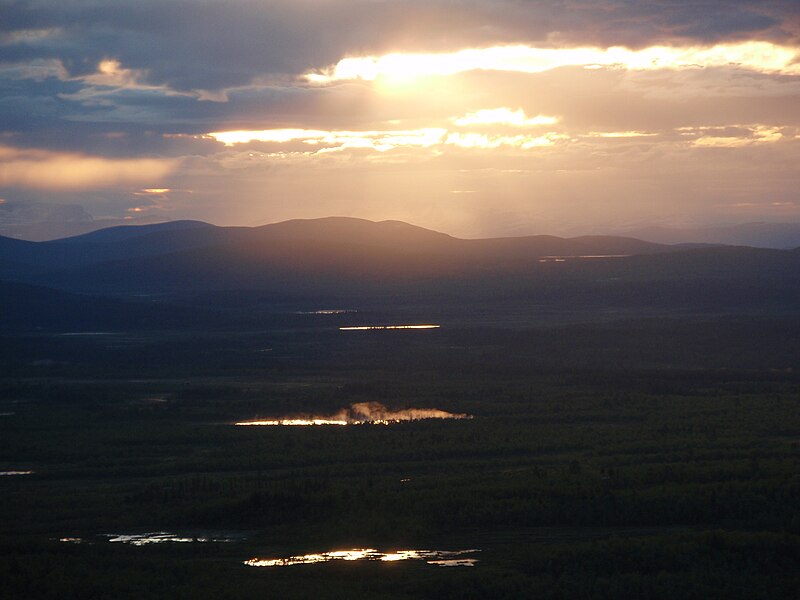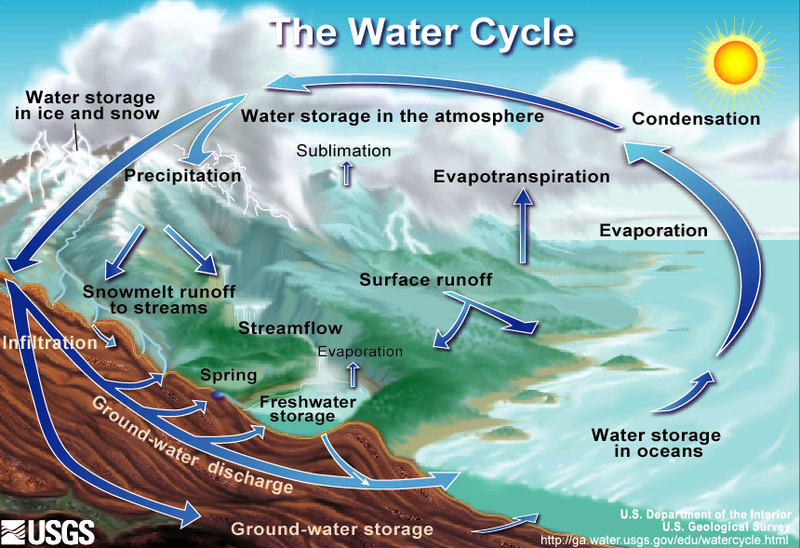If I were in charge of people touring taiga, these are five things I would want people to learn and remember about it:
1. In the summer, the sun doesn't set for weeks.
2. Taiga is the largest land biome, covering 11% of the Earth.
3. Peat bogs are widespread in taiga.
4. Taiga is Russian for forest.
5. Some of the oldest trees in the world are in taiga, such as a 4,600 year old bristlecone pine.
62°16'16.91"N
7°12'27.83"E
Wednesday, January 12, 2011
Phosphorus Cycle

The phosphorus cycle is a biogeochemical cycle which details the movement of phosphorus across Earth. Phosphorus is a common element which is essential to all life, as it forms ATP and DNA. While most abundant in the oceans as salt, it can also be found in the soil. This is because rocks in the ocean slowly move to land by geological processes, where they are weathered to become part of soil. In soil, plants absorb it, and it moves up the food chain. When these plants and animals die, it is returned to the soil. Runoff then returns phosphorus to the oceans. Phosphorus is always a solid in normal conditions, so it can not be found in the atmosphere.
58°15'19.32"N
4°10'58.25"W
Tuesday, January 11, 2011
Environmental Damage

Currently, the largest threat to taiga is deforestation. More than half of Canada's boreal forests are owned by logging companies to cut down. The main method of logging in Canada is clearcutting, or the removal of most or all trees in an area. This often leaves barren wastelands where entire ecosystems once were. However, many countries are starting to end this. Canada recently put over 13,000 square kilometers under protection. If more similar precautions were taken, deforestation would be a much lesser issue. If change doesn't occur quickly, boreal forests could all but disappear.
Another problem which taiga faces is global warming.Global warming is caused by the release of greenhouse gases into the atmosphere. The burning of fossil fuels by humans is the largest contributer. In 2007, it was estimated that the average surface temperature increased 1.3 degrees Fahrenheit during the 20'th century. Due to increased temperatures, many species have lost their habitats, especially in tundra. In taiga, global warming can cause forest fires and drunken trees. Recycling paper, plastic and metal makes a huge difference is combating climate change. This also leads to less deforestation. Another way to help is to use less gasoline and electricity. If global warming continues, there may be no polar ice left. This would lead to widespread flooding and countless deaths.
44° 6'36.51"N
142°38'29.55"E
Food Chain
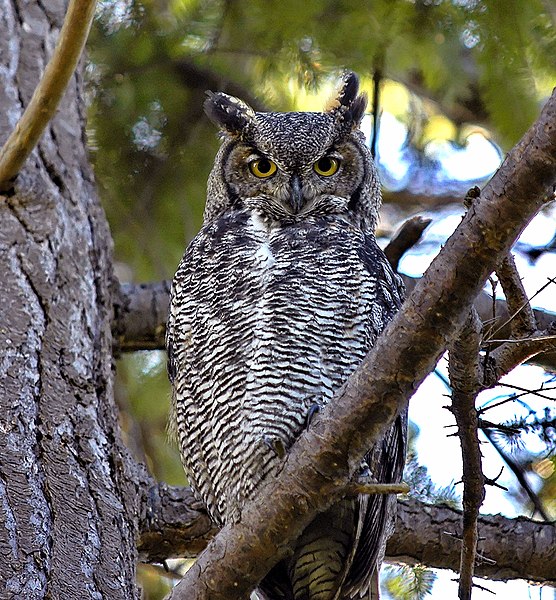
A food chain is a diagram of species in an area. Each level eats the level below it and is eaten by the level above it. At the bottom of the food chain is a producer. These species, usually plants, produce their own food from the sun's energy during photosynthesis. Next is a primary consumer. These are animals which eat plants exclusively. Secondary consumers eat primary consumers. These can be carnivores or omnivores. After these are tertiary consumers, then quaternary and so forth. These can be carnivores, omnivores, or decomposers. As the level becomes higher, the animals become larger but less numerous. When food chains combine to include all animals and plants species eat, a food web is formed.
Below is an example of a food chain which exists in Canada.
Quaternary consumer-great horned owl
Tertiary consumer-weasel
Secondary consumer-bird
Primary consumer-mouse
Producer-shrub
54° 0'15.30"N
77°43'22.27"W
Monday, January 10, 2011
Skunks

Skunks (family name Mephitidae) are a family of mammals which live throughout the Americas, including Canada. To deter predators, they excrete a foul-smelling odor. This is an example of aposematism. Another purpose of the odor is to make predators believe the animal is unpalatable. It also can cause temporary blindness and irritation. This spray is strong enough to ward off almost any predator, such as bears.
46°25'57.15"N
85°45'8.46"W
Snowshoe Hare


The snowshoe hare (Lepus american-
us) is a species of hare found throughout Canada and Alaska. This animal is significant for its fur, which changes color from white in the winter to brown in the summer. This is an example of camouflage, or blending in with the environment to hide. This adaptation was an evolutionary advantage because allowed snowshoe hares to evade predators.
53°21'20.28"N
110°51'45.52"W
Limiting Factors

A limiting factor is a factor that limits the ability for species to thrive. There are two types of limiting factors: density-dependent and density-independent. A density-dependent limiting factor is affected by the density of a population. In thick boreal forest, a density-dependent limiting factor can be light, which often won't reach the ground until a tree falls. Saplings will also have limited space to grow in this scenario.

A density-independent limiting factor is a factor which is unaffected by the size of a population. One such limiting factor througout taiga is temperature. Many species cannot survive the winters which taiga experiences. Cold temperatures will generally afftect small and large populations the same.Another density-independent limiting factor is a volcanic explosion. Plants and animals will be affected the same regardless of their population size.
65°41'6.55"N
150°57'29.18"W
Siberian Tiger

The Siberian tiger (Panthera tigris altaica) is a tiger subspecies which lives in east Siberia. Its conservation status in endangered. In the mid 1980's, there were only 250 individuals left in the wild. This population has slowly gone up since; it was about 350 in 1996 and 500 in 2005.
The diet of the Siberian tiger consists mostly of Wild Boar and Red Deer. It is a very large predator which can weigh over 700 pounds. It will also eat musk, sika deer, and goral, along with smaller animals like salmon, hares, and pikas. Unlike some other tiger species, it is very rare for a Siberian tiger to attack humans.
49°21'46.11"N
135°43'14.07"E
Primary and Secondary Succession

Primary succession is when new growth occurs in a location devoid of vegetation and soil. Common causes of primary succession in taiga are glaciers and lava flows. First, pioneer species colonize the area such as fungae, lichen, grasses, and wildflowers. These start to recreate the soil, allowing for small vascular plants to take over. As the area starts to contain larger plants, animals are attracted to it. Lastly, trees and other large plants join, and a climax community is created.

Secondary succession is the growth of plants in a an area where plants were destroyed, but the soil remains intact. In taiga, the main cause of this is wildfires. In fact, some species, such as the Jack Pine (Pinus banksiana) will only release seeds after a fire. The succession of growth is similar to primary succession, but there is no need for pioneer species.
50°23'21.34"N
100°51'0.83"W
Nitrogen Cycle

The nitrogen cycle is a biogeographic cycle which details the circulation of nitrogen through the biosphere. Within this are four major processes. One is fixation. Fixation is the conversion of nitrogen into ammonia by prokaryotes. This is meaningful because nitrogen is unusable by life, but ammonia is not. Another process is mineralization, which is the release of nitrogen during decomposition. Nitrification is the oxidation of ammonia and then nitrates. Last is denitrification, the process of reducing nitrate into nitrogen by bacteria.
60°21'4.59"N
87° 1'56.98"E
Carbon Cycle
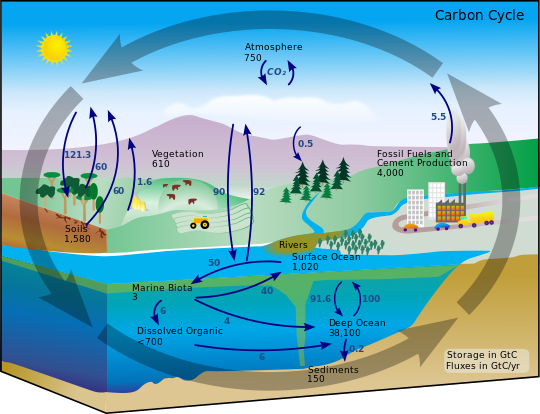
The carbon cycle is a natural cycle in which carbon is cycled through the Earth. It details the shifts between the major carbon resevoirs, which include sediment, the ocean, the terrestrial biosphere, the atmosphere, the crust and the mantle. In taiga, large forests are a major reducer of atmospheric carbon, which trees use in respiration. Taiga has the largest resevoirs of carbon in the world, both in its forests and peat bogs. Also, as there are few major urban areas in taiga, the release of carbon by burning fossil fuels is relatively low. However, many locations, such as Alaska, are mined for their fossil fuels, causing carbon to be taken out of the ground. Another cause of carbon release is volcanoes, which are common in southern Alaska and Iceland. These put carbon in the crust and mantle into the atmosphere.
61°14'33.25"N
113° 4'39.88"W
Sunday, January 9, 2011
Oslo, Norway
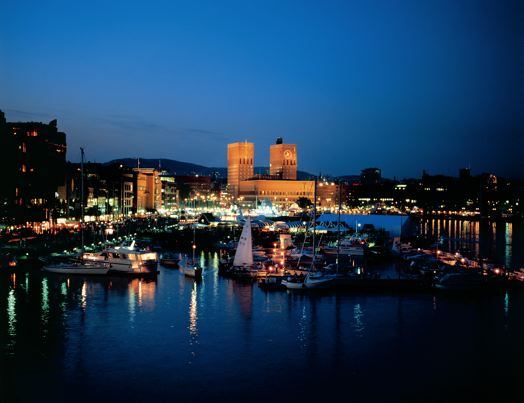
Oslo is Norway's capital and largest city. Located in southeast Norway, it is just inside of the southern border of taiga. It has about 600,000 inhabitants. Oslo has mild summers and cold winters. However, due to the Gulf Stream, the climate is warmer than its northern location would suggest.
| Climate data for Oslo | |||||||||||||
|---|---|---|---|---|---|---|---|---|---|---|---|---|---|
| Month | Jan | Feb | Mar | Apr | May | Jun | Jul | Aug | Sep | Oct | Nov | Dec | Year |
| Record high °C (°F) | 12.8 (55) | 15 (59) | 17.8 (64) | 26.1 (79) | 30 (86) | 33.9 (93) | 35 (95) | 34.4 (94) | 27.2 (81) | 23.3 (74) | 14.4 (58) | 12.8 (55) | 35 (95) |
| Average high °C (°F) | -1.78 (28.8) | -0.89 (30.4) | 3.5 (38.3) | 9.11 (48.4) | 15.78 (60.4) | 20.39 (68.7) | 21.5 (70.7) | 20.11 (68.2) | 15.11 (59.2) | 9.28 (48.7) | 3.22 (37.8) | -0.5 (31.1) | 9.56 (49.2) |
| Daily mean °C (°F) | -4.3 (24.3) | -3.9 (25) | 0.1 (32.2) | 5.0 (41) | 10.1 (50.2) | 15.5 (59.9) | 16.9 (62.4) | 15.7 (60.3) | 11.3 (52.3) | 6.6 (43.9) | 0.9 (33.6) | -3.1 (26.4) | 5.9 (42.6) |
| Average low °C (°F) | -6.78 (19.8) | -6.78 (19.8) | -3.28 (26.1) | 0.78 (33.4) | 6.5 (43.7) | 10.61 (51.1) | 12.22 (54.0) | 11.28 (52.3) | 7.5 (45.5) | 3.78 (38.8) | -1.5 (29.3) | -5.61 (21.9) | 2.39 (36.3) |
| Record low °C (°F) | -26.1 (-15) | -25 (-13) | -21.1 (-6) | -16.1 (3) | -4.4 (24) | 0.6 (33) | 3.9 (39) | 2.2 (36) | -3.9 (25) | -11.1 (12) | -16.1 (3) | -23.9 (-11) | -26.1 (-15) |
| Precipitation mm (inches) | 49 (1.93) | 36 (1.42) | 47 (1.85) | 41 (1.61) | 53 (2.09) | 65 (2.56) | 81 (3.19) | 89 (3.5) | 90 (3.54) | 84 (3.31) | 73 (2.87) | 55 (2.17) | 763 (30.04) |
| Snowfall cm (inches) | 14.1 (5.55) | 21.8 (8.58) | 21.4 (8.43) | 3.5 (1.38) | 0 (0) | 0 (0) | 0 (0) | 0 (0) | 0 (0) | 0.4 (0.16) | 4.3 (1.69) | 11.7 (4.61) | 77.2 (30.39) |
Oslo is situated above Oslofjord. A fjord is a narrow body of water surrounded by cliffs. These are usually carved by glaciers. However, Oslofjord is not technically a fjord, but rather a bay. This confusion stems from the fact that fjord can mean any body of water in Norwegian. There are many true fjords in Norway, such as Geirangerfjord, shown below.

59°54'46.92"N
10°45'8.40"E
Saturday, January 8, 2011
Midnight Sun
Midnight sun is a period of daylight which lasts for more than 24 hours. It occurs during the summer inside of the Arctic and Antarctic circles. At the edge of the Arctic circle, the sun doesn't set between June 12 and July 1. However, this becomes months further north. During the winter, taiga experiences the opposite phenomenon: polar night. This is the lack of daylight for more than 24 hours, but can be extended to include twilight.
 |
| Early afternoon in Tromsø, Norway |
18°57'18.30"E
Friday, January 7, 2011
Hydrologic Cycle
Commensalism and Parasitism

The brainworm (Parelaphostrongylus tenuis) is a parasitic nematode which resides in taiga. Its natural host is the white-tailed deer (Odocoileus virginianus). In other words, the brainworm uses the deer as a home and a place to reproduce without adversely affecting it. This is an example of commensalism. Both species live throughout North America, including much of Canada and northern America.
When the brainworm first hatches, it grows in the brain of the white-tailed deer. As a larvae, it then exits the animal through feces. Next, it infects gastropods such as snails and slugs. There it becomes mature. When an ungulate accidentally ingests an affected gastropod, the brainworms travel through the spinal cord to the brain, causing severe illness. Therefore, the brainworm is also a parasite. In taiga, the brainworm most often affects the moose, causing moose sickness.

45°56'15.94"N
68° 6'38.46"W
Thursday, January 6, 2011
Mutualism

One example of mutualism in taiga is moss growing on trees. This happens on many trees, especially further north in taiga. The moss benefits because it is given a spacious place to grow, and the tree is given a thick layer of protection.
59°44'48.54"N
153°54'36.59"W
Soil

The soil of taiga tends to be thin and acidic. It is also very nutrient poor. The cold hinders the growth of fauna, so the forest floor tends to have only lichens and moss on it. Some parts of taiga have permafrost, which is when soil is frozen year long. Most plants cannot survive in this, but some thrive, including the black spruce (Picea Mariana).
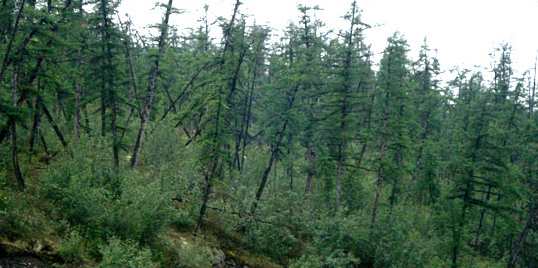 When permafrost melts, trees can become misaligned. Because of the thin soil, trees have shallow roots, which can allow them to tilt or even fall. This phenomenon is called "drunken trees". Drunken trees usually occur in taiga; specifically the black spruce. Entire forests can be destroyed by melting, making it a bellwether of climate change.
When permafrost melts, trees can become misaligned. Because of the thin soil, trees have shallow roots, which can allow them to tilt or even fall. This phenomenon is called "drunken trees". Drunken trees usually occur in taiga; specifically the black spruce. Entire forests can be destroyed by melting, making it a bellwether of climate change.49°49'58.01"N
124°28'12.63"W
Subscribe to:
Posts (Atom)

